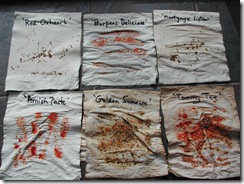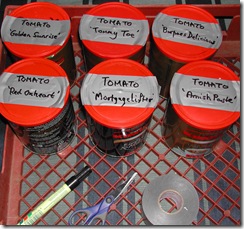It’s almost exactly the middle of winter, and the seed-saving tasks left over from summer are coming to an end – just tomatoes and sunflowers still to sort out…
Collecting tomato seed was described here, while photos of the tomato seed fermenting in their own juices can be found midway down the article here.  The gelatinous gloop that surrounds the tomato seeds has been left to do its job inside the storage containers, and with luck, the various diseases that can be carried forward from one tomato crop to the next via the seed have been nuked by this fermentation process.
The gelatinous gloop that surrounds the tomato seeds has been left to do its job inside the storage containers, and with luck, the various diseases that can be carried forward from one tomato crop to the next via the seed have been nuked by this fermentation process.
From here on, it’s only a matter of pouring the seedy fluid onto carefully-labelled absorbent paper kitchen towels and setting them to dry on a sunny window sill.
 With that step behind one, seed tins are labelled and dated (7/11 is all I will write on them to show a storage date of July 2011) then seed is scraped off the paper towel with a sharp knife or just a fingernail. So hey presto, seed for next year’s crop is stored in the seed collection, to be opened gratefully in a few months time when there’s a hint of spring in the air and my thoughts turn to the next tomato crop.
With that step behind one, seed tins are labelled and dated (7/11 is all I will write on them to show a storage date of July 2011) then seed is scraped off the paper towel with a sharp knife or just a fingernail. So hey presto, seed for next year’s crop is stored in the seed collection, to be opened gratefully in a few months time when there’s a hint of spring in the air and my thoughts turn to the next tomato crop.



0 comments:
Post a Comment